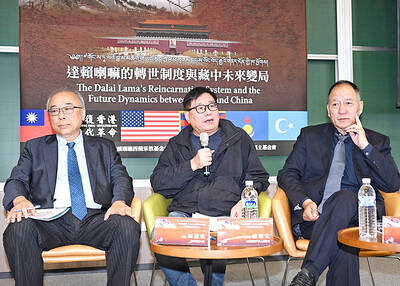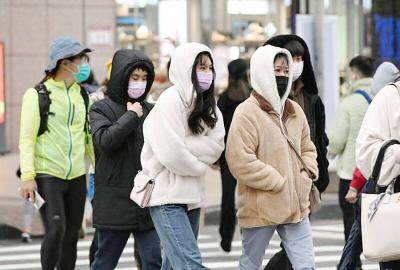Although the Ministry of National Defense and some Chinese Nationalist Party (KMT) legislators played down the significance of an incident involving two Chinese fighter aircraft in the Taiwan Strait late last month, analysts say the matter is more than simply routine.
Confirming on Monday media reports that one of two Chinese Sukhoi-27 fighter aircraft shadowing a US U-2 spy plane had crossed the median line in the Taiwan Strait on June 29, ministry officials maintained this was an isolated incident and did not regard it as provocative.
The Chinese aircraft are believed to have been from the 40th Fighter Regiment, 14th Fighter Division at Nanchang-Xiangtang Air Base in Jiangxi Province.
Although the intrusion — reportedly the first since an April 1, 2001, mid-air collision between a US Navy EP-3 aircraft and a Chinese J-8 fighter — prompted the ministry to dispatch two F-16s to intercept the Chinese fighters, KMT legislators said Beijing would not seek to provoke Taiwan at a time when relations in the Taiwan Strait are “at their best in decades.”
KMT Legislator Herman Shuai (帥化民), for one, said the incident was likely the result of pilot error.
A US Department of Defense spokesperson confirmed to the Taipei Times on Tuesday that a U-2 aircraft from the US Air Force was conducting a routine operation in international airspace in the area of the East China Sea on June 29.
As a matter of policy, the US official would not discuss details of specific missions or operations.
“In general, these reconnaissance flights are conducted in international airspace, as are the People’s Republic of China intercepts, which happen fairly routinely,” the spokesperson said. “There is no ‘repel’ aspect to them.”
US Pacific Command (PACOM), which has operational control of the surveillance flights, also confirmed the information.
A PACOM official contacted for comment said it would be inappropriate to speculate on the reasons why Chinese aircraft crossed the centerline in this particular incident.
Beijing has repeatedly called on Washington to cease the surveillance flights, claiming they infringe on its sovereignty and since 2007 China has frequently dispatched fighter aircraft close to the median line when such US surveillance flights occurred.
Asked to comment on the significance of last month’s incident, Roger Cliff, a specialist on the Chinese air force at the Project 2049 Institute, said it was more provocative than Taipei let on.
“Unless China has frequently done so in the past, which I doubt, crossing the centerline to shadow a U-2 is rather provocative,” he said. “I can’t think of any reason why China would start to do that at this particular time, but Beijing does regularly complain about intelligence and reconnaissance activities conducted against it, even when they are conducted in international waters or airspace. It is getting more assertive in its efforts to prevent them.”
Whether this was an isolated incident or another sign of China’s growing assertiveness, Taiwan should take this very seriously, Cliff said.
“Taiwan wouldn’t want the regularity with which such incidents [could] occur to cause them to stop responding. One day it might not be a probe, but rather the beginning of an actual attack on Taiwan,” he said.
Less alarmed by the incident was Gary Li, an intelligence analyst at UK-based Exclusive Analysis.
“The PLAAF [People’s Liberation Army Air Force] guys didn’t really do anything too aggressive, with one of them straying over the line for a little while,” he said, cautioning, however, that this could just be the agreed report given by both sides to avoid escalating the situation.
Asked to comment on the reasons why, barring pilot error, the PLAAF would have allowed one of its aircraft to cross the median line at this particular point in time, Li offered a number of possibilities, starting with the position that China would not have made the decision to violate the centerline lightly.
“Beijing could be sending a message to the US in light of the developments in the South China Sea by harassing their routine intelligence assets” in a matter reminiscent of the “harassing” of the USS Impeccable, a US naval survey ship, by five Chinese vessels off Hainan Island in March 2009, he said.
Another possibility, Li said, was that the U-2 was gathering intelligence that was highly sensitive — perhaps new missiles being deployed or new naval assets — which could have forced the Chinese to be more daring than they normally are.
It could also be that the frequency of surveillance missions by the US has recently increased, he said.
“Even though U-2 flights are routine, they still can monitor inland intelligence due to their altitude. So the argument that they were in international airspace doesn’t really mean much to the Chinese as far as intelligence preservation is concerned,” he said.
Li speculated that the two PLAAF aircraft were not Su-27s, but rather J-11s, as the 17,500m ceiling of the aging Su-27 would make it hard to threaten the high-altitude U-2, which usually operates at about 21,000m.
The J-11, a Chinese variant of the Russian-made Su-27, has an operational ceiling of 18,500m and is equipped with medium-range air-to-air missiles. Nanchang-Xiangtang Air Base has both Su-27UBK and J-11 aircraft.
If this was the case, the PLAAF may have wanted to demonstrate to the US that China now has the capability to threaten its high-altitude assets, Li said.

ALIGNED THINKING: Taiwan and Japan have a mutual interest in trade, culture and engineering, and can work together for stability, Cho Jung-tai said Taiwan and Japan are two like-minded countries willing to work together to form a “safety barrier” in the Indo-Pacific region, Premier Cho Jung-tai (卓榮泰) yesterday said at the opening ceremony of the 35th Taiwan-Japan Modern Engineering and Technology Symposium in Taipei. Taiwan and Japan are close geographically and closer emotionally, he added. Citing the overflowing of a barrier lake in the Mataian River (馬太鞍溪) in September, Cho said the submersible water level sensors given by Japan during the disaster helped Taiwan monitor the lake’s water levels more accurately. Japan also provided a lot of vaccines early in the outbreak of the COVID-19 pandemic,

Kaohsiung Mayor Chen Chi-mai (陳其邁) on Monday announced light shows and themed traffic lights to welcome fans of South Korean pop group Twice to the port city. The group is to play Kaohsiung on Saturday as part of its “This Is For” world tour. It would be the group’s first performance in Taiwan since its debut 10 years ago. The all-female group consists of five South Koreans, three Japanese and Tainan’s Chou Tzu-yu (周子瑜), the first Taiwan-born and raised member of a South Korean girl group. To promote the group’s arrival, the city has been holding a series of events, including a pop-up

TEMPORAL/SPIRITUAL: Beijing’s claim that the next Buddhist leader must come from China is a heavy-handed political maneuver that will fall flat-faced, experts said China’s requirement that the Dalai Lama’s reincarnation to be born in China and approved by Beijing has drawn criticism, with experts at a forum in Taipei yesterday saying that if Beijing were to put forth its own Dalai Lama, the person would not be recognized by the Tibetan Buddhist community. The experts made a remarks at the two-day forum hosted by the Tibet Religious Foundation of His Holiness the Dalai Lama titled: “The Snow Land Forum: Finding Common Ground on Tibet.” China says it has the right to determine the Dalai Lama’s reincarnation, as it claims sovereignty over Tibet since ancient times,

Temperatures in some parts of Taiwan are expected to fall sharply to lows of 15°C later this week as seasonal northeasterly winds strengthen, the Central Weather Administration (CWA) said today. It is to be the strongest cold wave to affect northern Taiwan this autumn, while Chiayi County in the southwest and some parts of central Taiwan are likely to also see lower temperatures due to radiational cooling, which occurs under conditions of clear skies, light winds and dry weather, the CWA said. Across Taiwan, temperatures are to fall gradually this week, dropping to 15°C to 16°C in the early hours of Wednesday